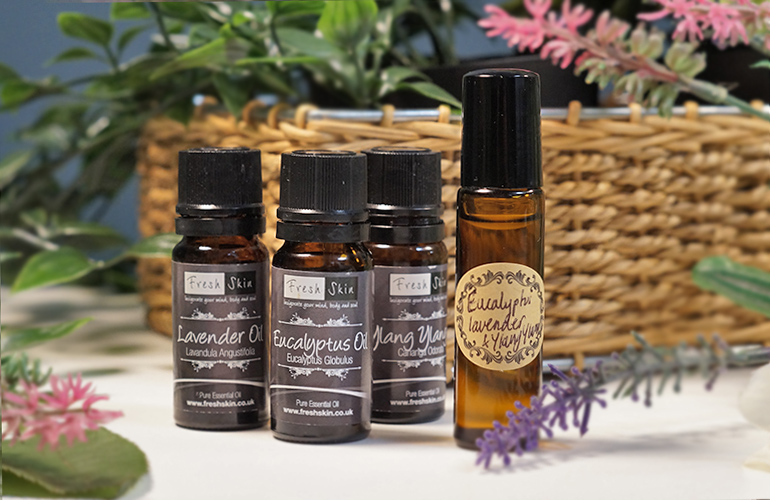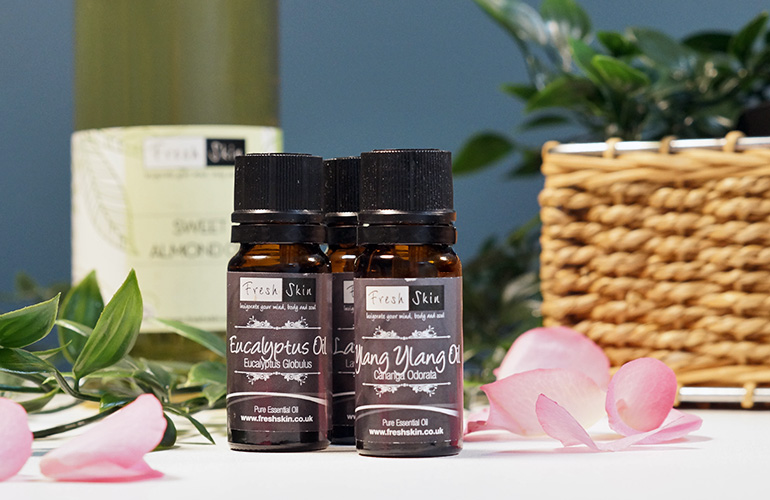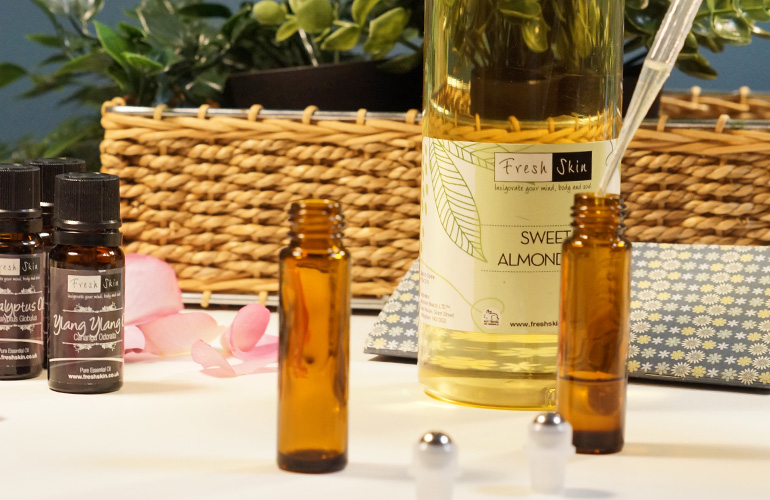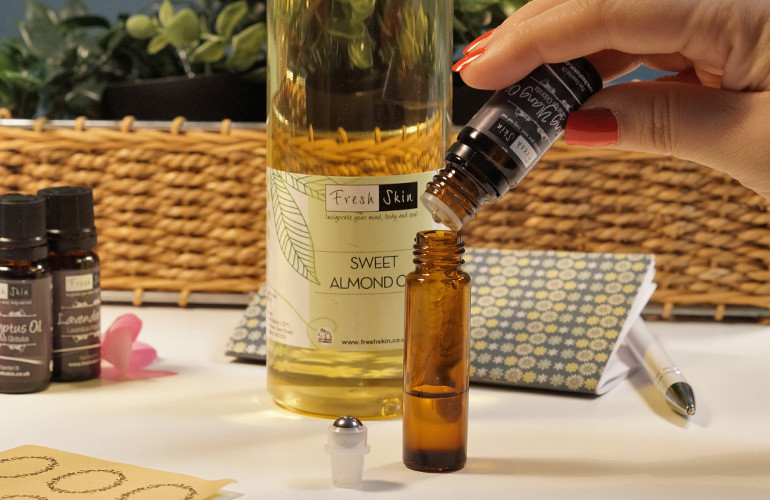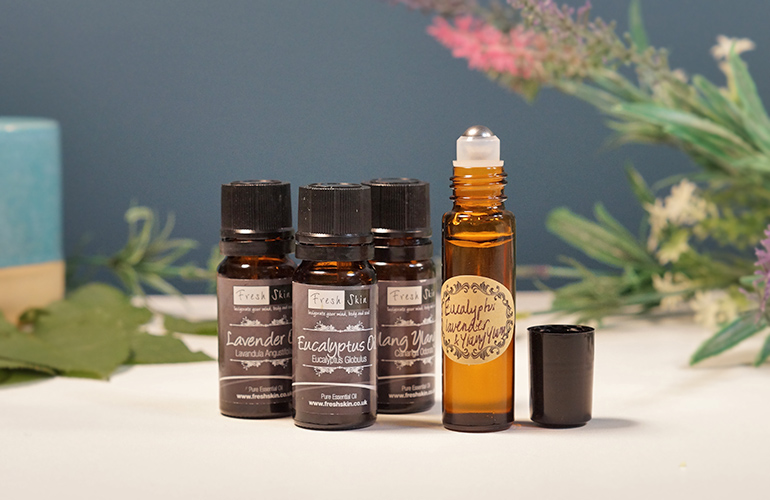Aromatherapy, Essential Oils, Fragrance Oils, Fragrances, How To, Skincare
How to Make Your Own Perfume With Essential Oils
With the origin of perfume dating back to the ancient Egyptian era, creating fragrances from natural plant and herb oils has evolved over 5000 years, with the first-ever ‘modern perfume’ created in 1370, under the order of Queen Elizabeth of Hungary. To this day, perfume remains a product of luxury and opulence, with major brands charging extortionate amounts for the smallest bottle of Eau de toilette.
The good news is that it’s fun, easy and incredibly cheap to create your homemade perfumes using beautiful fragrance blends and essential oils fit for royalty.
Hitting the right notes
Knowing how one scent works with the other is the starting point to understanding how to make perfume. Traditionally, fragrances are made up of three ‘notes’; top (30%), middle (50%) and base (20%). Top notes are what you smell in the first instance and fade much faster. The middle note then appears and is also known as the ‘core’ of your fragrance. Base notes do a lot of the hard work; they support the middle notes to extend their longevity.
Top notes
Because of their shorter longevity of around 10-15 minutes after application, citrus notes are favoured when choosing a top note, making a powerful yet welcoming first impact. Notes such as zesty lemon, punchy grapefruit and sunny bergamot are excellent choices, as well as warming basil, fresh peppermint and calming lavender.
Follow the link for these and many more top note recommendations.
Middle notes
The middle notes (lasting between 20-60 minutes after application) are the heart of your fragrance. Middle notes are full-bodied as they make up the core of your perfume and determine the dominant aroma. Middle notes in perfume commonly consist of oils with a herbal or floral nature and offer calming effects. For starters, try the mood busting clary sage, sweet rose geranium and soothing fennel.
Follow the link for these and more middle note recommendations.
Base notes
The pillars of your fragrance are your base notes. Lasting for upwards of 6 hours, they are the underlying and more prominent aromas. Once your top and middle notes have long faded, your base notes will linger the longest on your skin and have incredible staying power. These oils tend to be more musky and woody, full of depth and richness. Try the grounding scent of Patchouli, spicy Ginger and earthy Vetiver for an irresistible base.
Follow the link for our entire collection of base note recommendations.
Your DIY perfume-making checklist
Ensuring you have all the correct equipment to make your own perfume is essential. Here we share a checklist of the items you need to get started.
Essential oils
Now you have learnt all about the notes, select your top, middle and base essential oils. If you are still unsure what to choose, focus on the feelings you wish to encapsulate with your signature scent. Our ‘energising essential oils’ are great for uplifting. Perhaps our relaxing collection offers the sense of peace you are looking for. If you desire a fresh feeling of energy, discover our cleansing collection. For balance and calm, try our grounded collection. Our starter kits are also great for changing seasons, so embrace the joys of spring or settle down for the winter.
Check out our Blending Guide for more information about combining multiple oils to create your beautiful blend. Or make life even easier by using one of our pre-blended fragrance oils. Offering a vast range of aromas, Freshskin fragrance oils are carefully created to provide distinctive scents that mimic a huge selection of your favourite smells and several of the worlds most popular perfumes. Check out our Designer Fragrance collection for scents inspired by premium brands.
Whether you combine your own or choose a ready-made blend, all of our collections are there to guide you; your perfume is personal to you, so play around!
Carrier oils
A carrier oil is fundamental when making any perfume. Essential oils are potent and can irritate. Carrier oils dilute essential oils and make them suitable for use on the skin, ensuring hydration and moisture. Vegetable carrier oils and others also work well in protecting your skin. One of the most popular carrier oils is Jojoba Oil, rich in skin-nourishing vitamins C, E and A. Another great choice is Sweet Almond Oil packed with Vitamin D, ideal for sensitive skin.
Discover all of our carrier oils, including our organic range online, and checkout our Carrier Oil Guide for even more information about the benefits of each.
Measuring equipment
Accuracy and hygiene are fundamentals when you decide to make your own perfume. Glass measuring cylinders and beakers are excellent choices and can be washed with soapy water. Sterilise them with ethanol (another must!) before use. A thermometer is handy if you are creating recipes that require the ingredient to be at a specific temperature. If you plan on making a high volume of perfume and multiple products, digital scales are great for weighing out your completed blends.
Pipettes and testing strips
Pipettes are at the heart of the perfume-making process. Use them steadily and carefully to transfer your small amounts of liquid. Glass pipettes are considered the best option (rather than disposable pipettes) with better resistance to heat, solvents and acids. Remember to wash and sterilise them after each use and avoid mixing liquids at all costs. Don’t forget your eco-friendly testing strips for testing out incredible blends and the journey of the aromas as they develop.
Remember, this is the experimental bit and your blends won’t always hit the spot. It can be hard trying to judge your own homemade perfume blends, so call in a friend or loved one for some helpful feedback. You can easily pick up testing strips from your major online retailers.
Bottles and vials
The fun part of the process! Your fragrance is ready, and now it’s time to add your signature. Again glass is the best option for storing your homemade perfumes and are easy to sterilise for use time and time again. Invest in some high-quality bottles and dropper lids for your fragrance. Rollerball bottles are also an excellent choice for smaller quantities and fit perfectly in your bag when out and about. Head over to our Bottle and Accessories collection for inspiration.
Labels
After all of your hard work creating the perfect home perfume, have some fun, make a name for your scent to add a little personality, or if you are thinking of starting a small perfume business, brand your bottle!
The process – Making your own roll-on essential oil perfume
Gather your oils and equipment (four pipettes for starting out), and you are ready to start creating your homemade perfume.
Very important to note:
- Every ml of liquid is approximately 20 drops from your pipette or glass dropper.
- There should be no more than 20% concentration of essential oils in your carrier, and 15% is advised if you want to be cautious for those with sensitive skin.
- Remember, you can always add more, but you can’t take away, so start small and build up while resisting the urge to overdo it. Essential oils are incredibly powerful!
For starters, the below guide is for a 5ml (100 drops liquid) perfume. Once you hit the sweet spot you can start working up the volumes to create larger amounts.
Firstly add 80 drops of carrier oil to your bottle. Then with your remaining droppers, add the following in order:
- 10 drops of your essential oil base note/s
- 5 drops of your essential oil top note/s
- 5 drops of your essential oil middle note/s
- Or, try 10 drops of a chosen fragrance oil
You should then seal the bottle and shake it well. Because this is a completely natural perfume, you’ll need to give the bottle a good shake before each use.
You are done! Now simply add your label and enjoy your new fragrance. Oh, and don’t forget to note the precise details of the combinations you love!
How to apply perfume
Want to know the correct way to apply perfume? Maybe you want to know how to use fragrance so that it lasts all day? Here are some essential tips:
- Apply it directly to your skin – the best surface for the scent to express itself
- Add it onto your skin but over lotions – the oils from both will lock in the scent
- Apply it when you have just got out of the shower – the moisture of your skin will improve longevity
- Dab it onto your pulse points – do not rub; allow the area to dry naturally
- Walkthrough a ‘cloud’ of your fragrance – be sure not to inhale it too deeply
- Spray it on your clothing – only for washable fabrics and avoid delicate materials such as silk
- Do not use it in your hair – this can cause dryness.
Whichever essential oils or fragrance blends you choose for your first or next homemade perfume, be patient and play around with the different oils and combinations. By doing so, you will find one that is truly majestic.
Are you interested in creating other scented home and beauty products? Discover our complete collection of essential oils, fragrances, natural ingredients and accessories, all available with FREE UK delivery.


